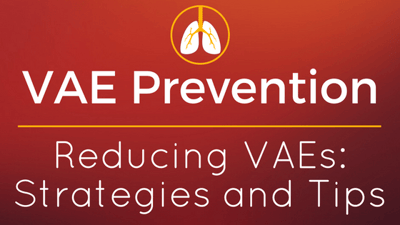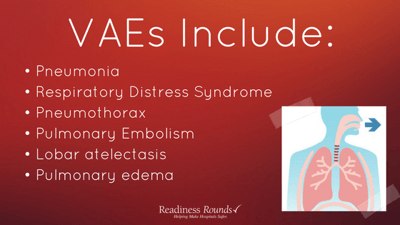
In the U.S. healthcare system there are approximately 1.7 million Healthcare-Associated Infections (HAIs) per year and 99,000 patient deaths per year due to HAIs. (3)
Ventilator Associated Pneumonia (VAP)
Of those infections, Ventilator Associated Pneumonia (VAP) is the second most common preventable HAI in ICU patients, occurs in approximately 9-27% of mechanically ventilated patients, and is the reason 50% of antibiotics are given to ICU patients. VAP carries with it a mortality rate between 9-50%. Ventilated patients are at risk for pneumonia due to the presence of the endotracheal tube interfering with natural defense mechanisms, such as cough reflex, and the potential for aspiration. (1)
Mechanical Ventilation
In addition to pneumonia, ventilated patients are at risk for several potential complications associated with mechanical ventilation. Due to definitions for surveillance differing from definitions used for clinical diagnosis, the CDC developed an algorithm for ventilator-associated events surveillance. The CDC surveillance definitions include ventilator-associated conditions (VACs), infection-related ventilator-associated complications (IVACs), possible pneumonia, and probable pneumonia. Approximately 5%–10% of mechanically ventilated patients develop VAEs. (2)
Ventilator-associated events or VAEs are a group of conditions that include:
- Pneumonia
- Respiratory Distress Syndrome
- Pneumothorax
- Pulmonary Embolism
- Lobar atelectasis
- Pulmonary edema (4)

VAE Questions and Answers:
Q: How do VAEs impact patients? The hospital?
A: VAEs increase patient duration of ventilation, total length of stay and ICU length of stay. They also increase the risk of death and antibiotic use and increase medical costs. (5)
Q: What strategies reduce VAE?
A: According to the 2014 IDSA/SHEA Practice Recommendations, the prevention strategies with a high quality of evidence include:
- Using noninvasive positive pressure ventilation (NIPPV) whenever appropriate.
- Interrupting sedation daily/spontaneous awakening trials for patients when possible.
- Assess readiness for extubation daily/spontaneous breathing trials for patients when possible.
- Pairing spontaneous breathing trials with spontaneous awakening trials.
- Changing the ventilator circuit only if soiled or not working.
- Use selective decontamination of the throat to decrease bacteria.
Moderate quality of evidence:
- Manage ventilated patients without sedatives whenever possible.
- Provide early mobility.
- Provide endotracheal tubes with subglottic secretion drainage ports for patients likely to require greater than 48 or 72 hours of intubation.
- Follow CDC/Healthcare Infection Control Practices Advisory Committee guidelines for sterilization and disinfection of respiratory care equipment.
- Perform oral care with chlorhexidine.
- Administer prophylactic probiotics.
Low quality of evidence:
- Elevate the head of the bed to 30-45 degrees.
- Ultrathin polyurethane endotracheal tube cuffs.
- Automated control of endotracheal tube cuff pressure.
- Saline instillation before tracheal suctioning.
- Mechanical tooth brushing.(2)
Q: What data needs collected and reported in order to reduce VAE rates?
A: IDSA/SHEA recommends monitoring and reporting patient outcomes and compliance to recommended prevention strategies.(2) Collecting compliance data and reporting it transparently is the cornerstone to improving! Once you are completing data collection regularly, the data should be presented and addressed at all levels of the organization.
- Find the issues that are failing at a high rate and use the data to drive the performance improvement team’s focus.
- Celebrate not only successes but also failures.
- Create a culture in which failure identification is celebrated and correlated with the ability to remediate before harm occurs. Finding errors in-process can be a great thing!
Interested in previewing Readiness Rounds' VAE rounding tool? Contact us for a demo.
Sources
1) https://ccforum.biomedcentral.com/articles/10.1186/cc13775
2) http://www.jstor.org/stable/10.1086/677144
3) http://www.cdc.gov/hai/pdfs/hai/scott_costpaper.pdf
4) http://www.cdc.gov/nhsn/pdfs/pscmanual/10-vae_final.pdf
5) http://www.aacn.org/wd/elearning/docs/elearningpdf/vae-ppt-handout.pdf